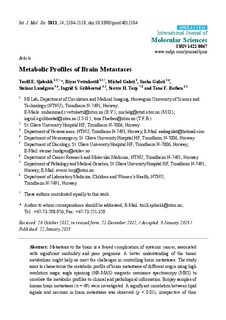Metabolic profiles of brain metastases
Sjøbakk, Torill Eidhammer; Vettukattil, Riyas M; Gulati, Michel; Gulati, Sasha; Lundgren, Steinar; Gribbestad, Ingrid S; Torp, Sverre Helge; Bathen, Tone Frost
Original version
International Journal of Molecular Sciences 2013, 14(1):2104-2118 10.3390/ijms14012104Abstract
Metastasis to the brain is a feared complication of systemic cancer, associated
with significant morbidity and poor prognosis. A better understanding of the tumor
metabolism might help us meet the challenges in controlling brain metastases. The study
aims to characterize the metabolic profile of brain metastases of different origin using high
resolution magic angle spinning (HR-MAS) magnetic resonance spectroscopy (MRS) to
correlate the metabolic profiles to clinical and pathological information. Biopsy samples of
human brain metastases (n = 49) were investigated. A significant correlation between lipid
signals and necrosis in brain metastases was observed (p < 0.01), irrespective of their primary origin. The principal component analysis (PCA) showed that brain metastases
from malignant melanomas cluster together, while lung carcinomas were metabolically
heterogeneous and overlap with other subtypes. Metastatic melanomas have higher
amounts of glycerophosphocholine than other brain metastases. A significant correlation
between microscopically visible lipid droplets estimated by Nile Red staining and MR visible
lipid signals was observed in metastatic lung carcinomas (p = 0.01), indicating that the proton
MR visible lipid signals arise from cytoplasmic lipid droplets. MRS-based metabolomic
profiling is a useful tool for exploring the metabolic profiles of metastatic brain tumors.
